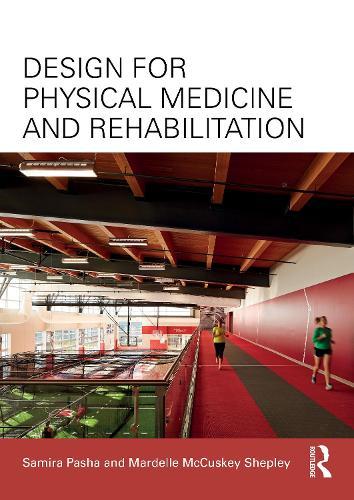Full Product Details
Author: Samira Pasha ,
Mardelle McCuskey Shepley
Publisher: Taylor & Francis Ltd
Imprint: Routledge
Weight: 0.453kg
ISBN: 9781032936536
ISBN 10: 1032936533
Pages: 196
Publication Date: 25 November 2025
Audience:
College/higher education
,
Professional and scholarly
,
Tertiary & Higher Education
,
Professional & Vocational
Format: Hardback
Publisher's Status: Forthcoming
Availability: Not yet available

This item is yet to be released. You can pre-order this item and we will dispatch it to you upon its release.
Reviews
""Rehabilitation professionals improve quality of life by enhancing movement and daily activities, reducing pain, restoring function, and preventing disability. Good healthcare facility design can significantly contribute to a therapist’s capacity to achieve these goals while also avoiding caregiver injury. Clinical settings must support therapists as they push their patients' physical limits, while ensuring safety for both the patient and the therapist. Mobility is Medicine. A well-designed environment will enable caregivers to treat patients, thus limiting the negative effects of immobility such as falls, pressure injuries, muscle and bone weakness, blood clots, incontinence, constipation, depression, fainting, and loss of independence. The content of Design for Physical Medicine and Rehabilitation is essential to designers and facility design teams who are planning new rehabilitation spaces that strive to enable therapists and patients to achieve their healthiest lives."" Nancy McGann PT, CSPHP, CPPS, Enterprise Manager of Safe Mobility, Intermountain Health
“Rehabilitation professionals improve quality of life by enhancing movement and daily activities, reducing pain, restoring function, and preventing disability. Good healthcare facility design can significantly contribute to a therapist’s capacity to achieve these goals while also avoiding caregiver injury. Clinical settings must support therapists as they push their patients’ physical limits, while ensuring safety for both the patient and the therapist. Mobility is medicine. A well-designed environment will enable caregivers to treat patients, thus limiting the negative effects of immobility such as falls, pressure injuries, muscle and bone weakness, blood clots, incontinence, constipation, depression, fainting, and loss of independence. The content of Design for Physical Medicine and Rehabilitation is essential to designers and facility design teams who are planning new rehabilitation spaces that strive to enable therapists and patients to achieve their healthiest lives.” Nancy McGann PT, CSPHP, CPPS, Enterprise Manager of Safe Mobility, Intermountain Health
Author Information
Samira Pasha, M.Arch (4+2), PhD, AIA, LSSGB, is a project executive with Hammes Healthcare where she is involved with projects during programming, design, and construction stages. Prior to this role, she practiced as a US-based architect and planner on healthcare projects located in the United States, South America, and the Middle East. Dr. Pasha’s research journey started with completion of her PhD dissertation at Texas A&M University, College of Architecture. Her research has been focused on pediatric healthcare environments, mental and behavioral health facilities, and rehabilitation environments; and has been published in peer-reviewed journals and in the form of a book, Design for Mental & Behavioral Health (2017). Mardelle McCuskey Shepley, BA, M.Arch, MA (Psych.), D.Arch, WELL AP, LEED AP, DAC, emerita FAIA, is an emerita professor at Cornell University in the Department of Human Centered Design and emerita Director of the Cornell Institute for Health Futures. She worked 16 years in architectural/design firms prior to becoming an academic and continues to consult. She is founder of ART+Science, Design Research Consultants. Dr. Shepley has authored/co-authored seven books, including Healthcare Environments for Children and their Families (1998), A Practitioner’s Guide to Evidence-based Design (2008), Design for Critical Care (2010), Health Facility Evaluation for Design Practitioners (2010), Design for Pediatric and Neonatal Critical Care (2014), Design for Mental & Behavioral Health (2017), and Peace by Design (2025).



